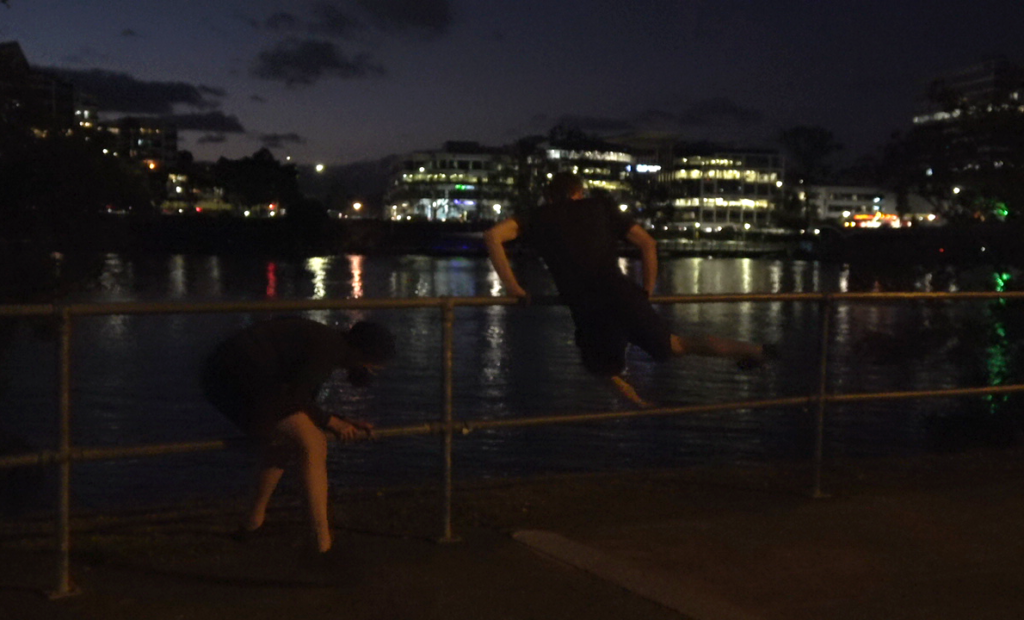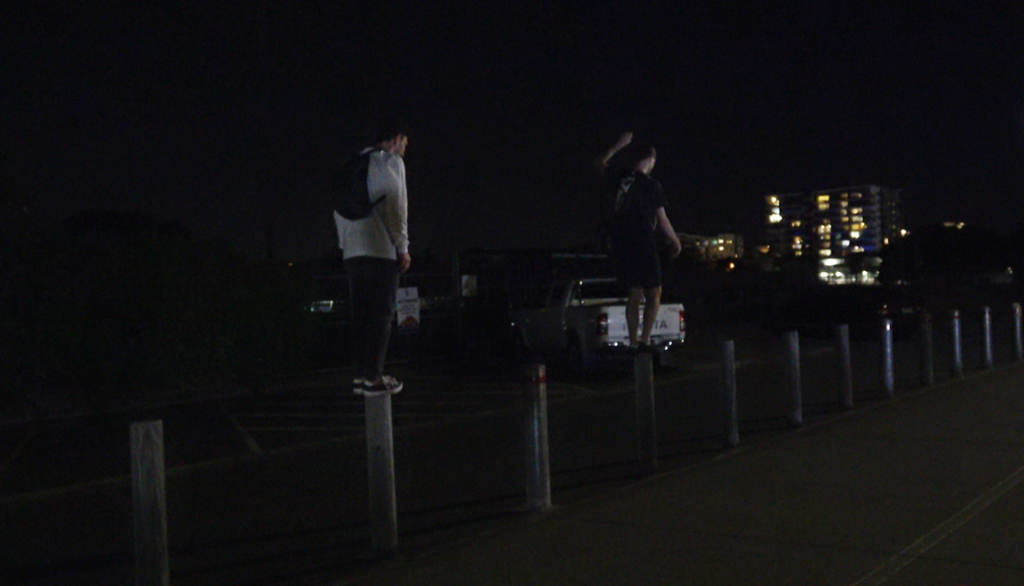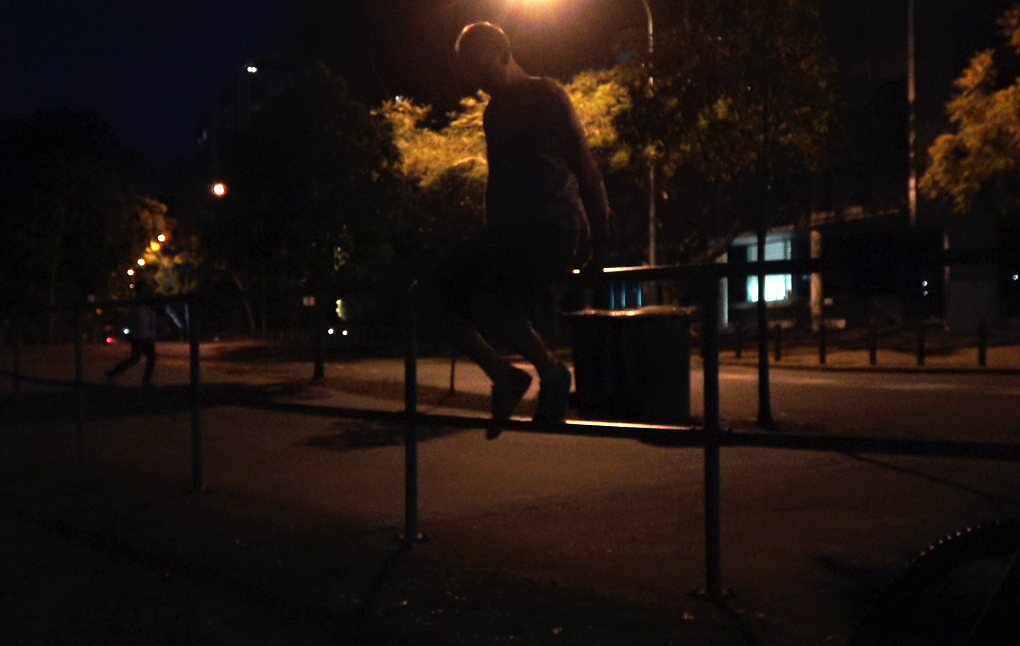Parkour and the exploration of identity through movements
By Estelle Sanchez
First written in November 2021
Dim is looking at the jump ahead of him. Just a few meters away, there is a platform where two trees are planted, nearly touching. It creates the illusion of a small circle made out of the twisted trunks. The young man intents to jump while flipping through the small interstice on to the other side of the platform. If he’s not precise enough, he could hit the tree in full swing and end up with a concussion or worse. Concentrated, he’s calculating. His friends cheer him up. He flips his hair on the side, wipes the bottom of both his feet, makes sure no one is coming his way as he starts running. Everything goes fast. He takes a run-up, flips in between the trunks. His shoulder brush past one of the trees, but he makes it to the other side only slightly shaken.
“That one was scary”, he said.
If you go out on the street in Brisbane, near Jacobs Ladder at the corner of Turbot Street and Edward Street, you’re likely to find the parkour jam, a group of young people, mainly all males training towards the benches or the stairs in the square, attempting jumps. If you’re lucky, you might see one going all in for a precision jump of several meters combined with a flip, to then climb a wall, and disappear. Impressive but scary. But why are these individuals so intently risking their safety or even their lives to rise up to a challenge?
During childhood, everything was an adventure. Everything around us a pretext to discover, climb, jump, and play. We were not scared of anything. Of course, we would only jump from a foot-tall step or bench. But our imagination would do the rest and we would envision our jump to be a few meters taller and that we just escaped out of a burning building. As we grew up, we learned how to act “normally” in a public setting. We became more scared of what could turn out wrong, of how we could hurt ourselves. Fortunately or unfortunately, depending on where you stand, it’s not the case for everyone. Dim, others in Brisbane and around the world are still doing what everyone loved to do as kids after having reached adulthood. They decided that their way of hanging out together will involve attempting tricks and jumps in the streets. Except this time around, the stakes are higher, the jumps aren’t necessarily close to the ground and all movement is permitted and explored.
From the perspective of someone who sees only a few seconds of a big jump, these guys seem to be daredevils who could fall and break their neck any second, but keep on asking for more. Others, maybe more like me, might get intrigued, remember what it was like as a kid to play with everything around you and could even wonder what would happen if they attempted it. There’s something compelling in seeing athletes perform crazy movements and jumps in the middle of the street, where everyone walks. Their space is accessible, it’s looking at us, daring us to wonder: why not me ?
On a Thursday night, about ten people gathered at sunset in a corner of West End, right next to the rowing club. No gear, not a lot of light on the street. Josh, the teacher, suggested exercises to the group and they would execute. First, using the barriers on the bikeway, he would ask his students to go through the bars without touching them, adopting a sort of cat walk that would help them have fluidity in their movements. Once a few people have had a chance to try it, he would show different movements they could do: climbing the barrier to cross it, using the lower bar to help you if needed, or if you could, jumping feet first on the higher bar.

The idea of their warm-up was to start with simple movements and test that they would feel completely comfortable with it, that they would be in complete control of their body while doing it. Some people were coming for the first time like George, curious to try parkour after one of his friends told him about it. Others, like Alex, were more advanced and confident in their abilities.
There was no rush to finish a movement. Whether it was on a post, on a barrier, on a wall. Alex had a perfect control over what he decided to do. It wasn’t necessarily about the difficulty of what he was attempting, but rather, a precision in his movements. He radiated such confidence that he would have made anyone question how much they knew their own bodies.

As the night became darker, they started to move along their environment, stopping whenever a new opportunity came to someone’s vision. Walking on polls and crossing them, attempting it in synchronisation with one of their friends. Everyone spread out, finding their own thing to work on. Mini groups were created whenever people wanted to work on the same challenge
Really quickly, I felt like my camera was preventing me from completely embracing what was taking place in front of me. I decided to put it down and give it a go myself. The nighttime set a particular atmosphere to the scene. It felt like I’ll be able to do more, I didn’t have the same vision of the obstacles as I would have had in daylight. The movements everyone was doing weren’t spectacular, there wasn’t an inhuman aspect to it and I quickly realised the discipline might not be only about attempting the biggest jump. I ended up asking one of the girls how she was able to climb a wall and attempted it myself. She explained the technique, I got it pretty fast but the strength was missing. I really wanted to make it and we started to jump alternatively for a substantial amount of time. While I didn’t make it to the top of that wall, I understood the drive to try again and again on a movement, to want something so badly that you could stay there for hours on end until you got it right.
Parkour as a vocation
Ansel Kunert, 23, discovered parkour in 2013 via a YouTube video. He instantly loved it and attempted it right after. Since then, he has never stopped practicing with his friends. From the beginning, he considered it as a definite, an activity he wouldn’t have to constantly question whether he wanted to keep doing it. It was just a foregone conclusion. “Parkour is one of those things that just gives me infinite energy. If everything else in my life changes, I’ll still always do parkour. Like I’ll be homeless and I’ll still be doing jumps, yeah.” Parkour allows him to have fun with his friends whilst testing his own limits and getting to know himself better.
“For me it’s like, I can show who I am through my movements. It’s an expression of yourself. You can create a course and the tricks you put in it, they’re made by your mind.”
Ansel Kunert
What Ansel enjoys the most about the discipline is the freedom people benefit from in their movements and the creativity that comes out of it. People can take ideas and movements from other disciplines such as martial arts, skating, gymnastics or breakdance and incorporate it into parkour. “People do such strange tricks. Some people would say: ‘that is so dumb’. But other people would be like: ‘No one’s done that before’.”
Every week, a new trick is invented, practitioners push the boundaries of what it considered possible and it is a thrilling experience. “Tricks that were crazy in 2014 are just not crazy anymore. We are all raising as a sport. Everyone’s skill levels come up altogether”, Ansel said.
Brisbane has a strong community of practitioners within parkour, an association dedicated to providing lessons to those curious about it and athletes that either choose to stay on their own in the jam community or join the association.
Vice president of the Brisbane Parkour Association and parkour teacher, Josh Wit, has trained with the founders of parkour in Europe during a few months and considers parkour as a way to develop one’s ability to overcome obstacles, both physical and mental. For him, it involves movement that will help if one is in an emergency situation.

“There is no set defined delineation of: ‘you’re capable of this, therefore you’re at this level.’ […] It’s all about simply progressing from where you are,” he said.
Josh Wit
Josh prefers measuring challenges by sight. It’s not about considering how far he can go based on what he did last week. It’s having done it so many times and being so comfortable with his own body, that he knows, whether he can do it or not by looking.
“I was looking at a jump, which some people had done, precision jump, which is jumping from one wall to another. It was about one meter high.
“One of the founders said he was prepared to spot me. He was standing there encouraging me, but I was […] looking at it: “Mmm not too sure!” And then he told me: ‘Don’t do it if you can’t do it because I can’t catch you.’ “
“So did you do the jump ?,” I asked.
“No, I backed out because I didn’t feel it.”
Josh explains people from outside only get that one instant of a stunt. They would imagine themselves in that scenario, realise how little they could do in that position and automatically would consider it as dangerous.
“If a seven-year-old was looking at jumping off that bench there, you’d think: ‘No, they’re going to hurt themselves, they really shouldn’t be doing that’. But if I jump off something which is higher to account for my height, something that’s equally difficult, you wouldn’t blink. […] It’s only because I’ve done it before, because I’ve trained. But to the toddler, it’s like they’re going to die.”
Josh Wit
This way of seeing parkour aligns with how the discipline started in the beginning.
Founder of the Parkour Generations organisation, Dan Edwardes, has witnessed the emergence of parkour, spent some time in France with the founders and brought the discipline back to England where it grew exponentially from there. “This is how it began. It was a way of training yourself, your body, and your mind to be as capable as competent and as resilient as possible in any scenario. ‘Be strong to be useful’ was their motto’.” Dan explains all the members put their input into creating parkour. They were young men, predominantly, with one or two women and they were influenced by ideas of superheroes and martial arts, anime and ninjas, or soldiers in action. “They drew from all these elements to try to find their own way to become a version of those heroic ideals and models,” he said.
A split between old and new generation
As parkour grew worldwide, a split started to appear as omnipresent in the community of practitioners between those who practiced parkour for what it was in the beginning and those who discovered it through its performative aspect. For Dan Edwardes, the spread of the discipline through social media and platforms like YouTube transformed the vision of the discipline, by making it look like something that necessarily had to be a performance.
“People don’t want to watch hard physical training, or people climbing mountains, it’s not so interesting right?
“But you do want to watch some guy doing a crazy flip over a wall and landing in the water twenty meters away.”
Dan Edwardes
“So that became the thing to do because there was an audience for that. Obviously more people are going to start on seeing that, training that, and copying that,” he said.
By only looking at the community in Brisbane, the split is already obvious between some practitioners that are part of the association and those who started to train on their own through the jam. The “daunting lessons” Ansel, Dim and his friends all took at the Brisbane Parkour Association, where you crawl on the ground, repeat the same movements a lot and do conditioning, did not align with what they wanted to do. “People can get stuck in those sort of lessons. Learning the same thing every week. We got bored of them and we just wanted to train normally”. Parkour has to remain a fun activity first and foremost for them. It has to be about the movements they want to try, not necessarily about discipline. “The reason we get the skills that we do, is because we do what we want to do” said Ansel.
Sean Harrison and Alexis Evans have practised parkour for several years with the BPA association, and on the opposite, they don’t need to go for big stunts, but rather consider that they challenge themselves physically enough to be able to feel more confident in how they use their environment and bodies.
For Dan Edwardes, that older version of parkour that aims to use training as personal development would be a smarter way to look at things because it would help people become better humans. If training has a positive impact on people, they’re more than likely to be of benefit to society.
“Showing off with big stunts, it’s fun for a 30 seconds YouTube video, but what does it really do for the development of the human race?
“So, you have to decide as an individual, what do you want ?”, Dan asked.
D. Edwardes
It seems there are as many ways to consider parkour as there are practitioners. Some consider there are major splits in the community: people who do the right thing and others who don’t practice correctly. Isn’t it funny to realise when comparing what people do on a training session, when it all comes down to the movements, all those differences aren’t that noticeable.
People are gathering in a group in the streets and have challenges in mind on how to use their environment: it’s what brought them together. They give each other advice, train for long hours and at the end go have dinner together.
Parkour is freedom of movement, creativity in perpetual evolution. It is more of a large principle of life than it is a set theory as a discipline. It is what people make of it.


August 2, 2022 @ 3:31 am
Itís nearly impossible to find educated people about this subject, however, you seem like you know what youíre talking about! Thanks
August 5, 2022 @ 12:04 pm
Top ,.. top top … post! Keep the good work on !
September 24, 2022 @ 9:13 am
Top site ,.. amazaing post ! Just keep the work on !
December 11, 2022 @ 1:35 am
Okay, this might be a little bit random, but I saw your blog and had to ask, are you interested in a translation job? I know I’m a stranger but I felt like doing a good deed today by alerting a couple people that a good position has opened up here: https://msha.ke/freedomwithtay and they pay sometimes even $70/hour. Okay, they won’t always give that amount, I only made around $400 last week, but it’s part time and when times are tight, every little bit helps. Hope it helps, and my apologies if you’re not interested. Have a great day/evening!
January 13, 2023 @ 12:32 pm
Hi, I’m only seeing this now but I’m intrigued, what is this job about? The link you gave me doesn’t give much detail.
December 11, 2022 @ 2:56 am
Hey there! This post couldn’t be written any better! Reading through this post reminds me of my old room mate! He always kept talking about this. I will forward this write-up to him. Fairly certain he will have a good read. Thanks for sharing!
December 17, 2022 @ 7:53 pm
Hm,.. amazing post ,.. just keep the good work on!